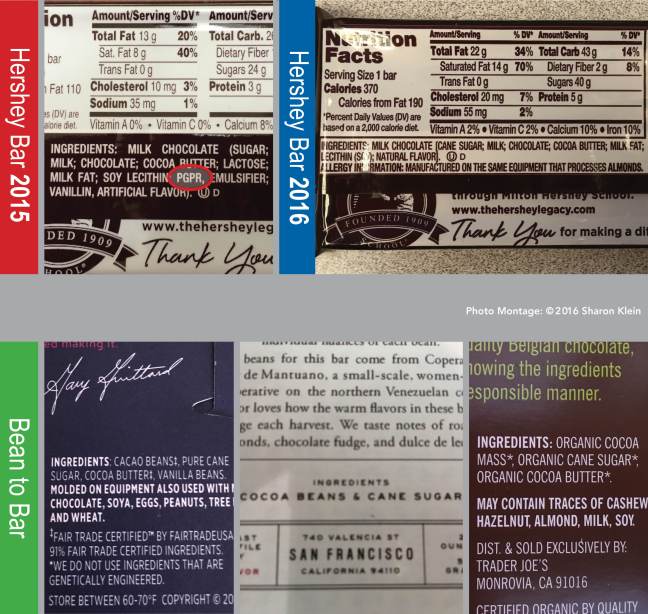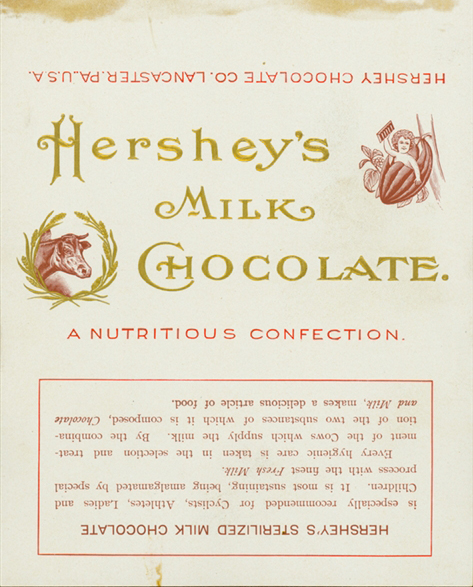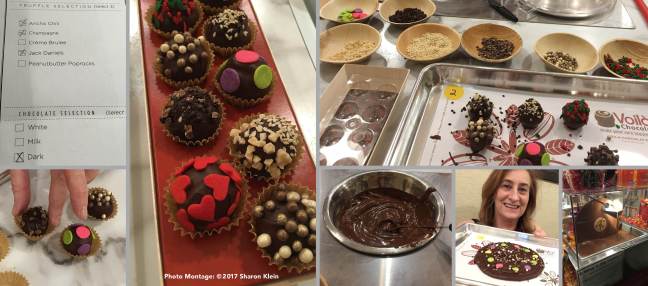
I actually can’t remember the last time I ate a Hershey’s Milk Chocolate bar. It could be 15 years ago and around the time I began my love affair with dark chocolate. Though it is possible my first taste of “dark chocolate” was when I tried the Hershey’s version. I didn’t buy another bar, but that led me to broaden my horizons and discover Belgian dark chocolate.
Back then I also didn’t think too much about ingredients, I was somewhat conscious — more than the average person. Now I am interested in what I consume for health reasons and also because my body has become far more sensitive to additives and white sugar.
Nielsen (who studies consumers in more than 100 countries to give the most complete view of trends and habits worldwide) says the current trend is towards cleaner, simpler ingredients in our foods and more transparency in the labeling. “Artificial is out, many of us avoid foods with long lists of ingredients, and consumers are intent on removing the bad and adding the good. A majority of global respondents say that when it comes to ingredient trends, a back-to-basics mind-set, focused on simple ingredients and fewer artificial or processed foods, is a priority. In fact 75% of global respondents say they’re worried about the long-term impact of artificial ingredients. 68% strongly or somewhat agree they’re willing to pay more for foods and drinks that don’t contain undesirable ingredients.”
I remember noticing a strange ingredient PGPR on the Hershey label a couple of years ago and wondered what it meant and whether it was used in other chocolate candy products. Seemed to just wiggle it’s way in. When I asked an expert, I was told that the ingredient was “very” not so good for you. Hmmmm. By using it in their formulation Hershey’s was able to add less cocoa butter (an expensive ingredient) and then sell that same cocoa butter to the cosmetic industry and make an even larger profit.
For this blog I did two things; take took a look at a current bar’s ingredients and finally read up on PGPR (Polyglycerol Polyricinoleate). I was pleasantly surprised to see the new label shows a simpler ingredient list and the absence of PGPR. Interestingly, Hershey’s website now has sections about transparency and what’s inside their products.
Today’s bean to bar dark chocolate crafters very often use only one to two ingredients; cacao and some form of sugar. That is all you really need to create an amazing tasting bar.

Below is the Wikipedia description of PGPR and it rings pretty true to what I originally heard. The main ingredient being Glycerol.
Polyglycerol polyricinoleate (PGPR), E476, is an emulsifier made from glycerol and fatty acids (usually from castor bean, but also from soybean oil). In chocolate, compound chocolate and similar coatings, PGPR is mainly used with another substance like lecithin[2] to reduce viscosity. It is used at low levels (below 0.5%),[3][4] and works by decreasing the friction between the solid particles (e.g. cacao, sugar, milk) in molten chocolate, reducing the yield stress so that it flows more easily, approaching the behaviour of a Newtonian fluid.[4] It can also be used as an emulsifier in spreads and in salad dressings,[5] or to improve the texture of baked goods.[5] It is made up of a short chain of glycerol molecules connected by ether bonds, with ricinoleic acid side chains connected by ester bonds.PGPR is a yellowish, viscous liquid, and is strongly lipophilic: it is soluble in fats and oils and insoluble in water and ethanol.[3]
Manufacture: Glycerol is heated to above 200 °C in a reactor in the presence of an alkaline catalyst to create polyglycerol. Castor oil fatty acids are separately heated to above 200 °C, to create interesterified ricinoleic fatty acids. The polyglycerol and the interesterified ricinoleic fatty acids are then mixed to create PGPR.[6]
Use in chocolate: Because PGPR improves the flow characteristics of chocolate and compound chocolate, especially near the melting point, it can improve the efficiency of chocolate coating processes: chocolate coatings with PGPR flow better around shapes of enrobed and dipped products,[7][8] and it also improves the performance of equipment used to produce solid molded products:[8] the chocolate flows better into the mold, and surrounds inclusions and releases trapped air more easily.[2] PGPR can also be used to reduce the quantity of cocoa butter needed in chocolate formulations: the solid particles in chocolate are suspended in the cocoa butter, and by reducing the viscosity of the chocolate, less cocoa butter is required,[2] which saves costs, because cocoa butter is an expensive ingredient, and also leads to a lower-fat product.[9]
Safety: The FDA has deemed PGPR to be Generally recognized as safe for human consumption,[1] and JECFA[3] has also confirmed its safety. Both of these organizations set the acceptable daily intake at 7.5 milligrams per kilogram of body weight. In Europe, PGPR is allowed in chocolate up to a level of 0.5%.[3] Short-term studies on rats and chickens showed reversible liver enlargement as a result of higher doses of PGPR, but those were deemed a result of increased hepatic (liver) workload.[10] In India, PGPR is allowed in specific products e.g. Gums. In a 1998 review funded by Unilever of safety evaluations from the late 1950s and early 1960s, “PGPR was found to be 98% digested by rats and utilized as a source of energy superior to starch and nearly equivalent to groundnut oil.”[11] Additionally, no evidence was found of interference with normal fat metabolism, nor with growth, reproduction, and maintenance of tissue. Overall, it did not “constitute a human health hazard.”[11]





You must be logged in to post a comment.